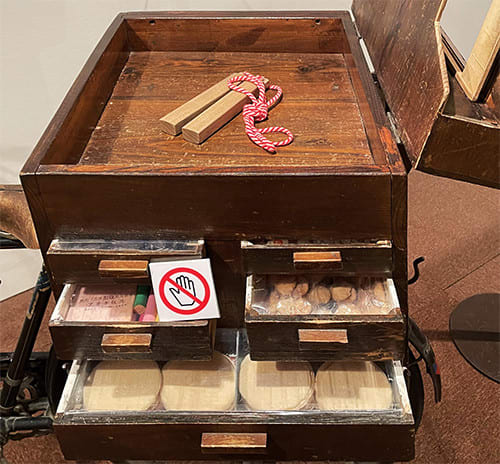

どうもわたしのブログは、コロナ禍以降、「生活文化探求」の方向が強まってきた。冷静な自己分析。現場的な住宅取材はスタッフが頑張っている中で自分自身はこれまで全般的な住宅業界動向を「掘り起こし型」で取材してきていた。それがユーザー動向と連動してナマの市場把握に繋がると考えていた。それが4年前に感染症警戒から社会的情報遮断が一般化した。
その間も住宅取材はいろいろな困難を超えて継続できてきていた。もちろんさまざまな困難要因はあったけれど、取材先のご協力をいただいて継続できたことはある意味、奇跡的だったかも知れません。感染症の最中でもユーザーの家づくりのリアルを取材できていたことは、一定期間経過したら、きわめて重要な「記録情報」にもなり得ると考えています。「感染症の中で日本の家はどう作られていたのか?」。
一方で、業界横断的な情報交流については、4年を経過してようやく徐々にリアルで復活しつつある。それでも自由度はきわめて低いレベルだと思います。
そんなことから、勢い「住文化」の掘り下げ型の活動が不可避になっていたのだと思います。住宅は人間の「暮らしのイレモノ」なので、そこに生きる人びとの生活実感を把握することが大前提。そういう意味で、生活文化の実相を深掘りしていくのは、多くの経験を積んできた者の責任でもあるのでしょう。


生活の歴史、日本人的な感じ方として現代人の直接的な経験であって、意識下で大きな要因になっているものに「戦後期の少年少女向け文化」というものがある。たぶんいまの社会をリードしている人びとの感受性の起点になっている。その後のテレビ文化など大衆文化の起点としての確認が必要でしょう。
以前にも紹介した「台東区立下町風俗資料館」展示で、案の定「紙芝居」についての展示があった。わたしは幼年期、具体的には3才から10才くらいまでの期間で接していた記憶がある。いちばん上の写真はモノクロの記録写真として同館に展示されていた。街角の一角で子どもたちが放課後、遊んでいるところを選んで、即興のメディアが出現していた。自転車の荷台が木工で工夫されて展示装置に変わっていった。画面にはストーリーマンガが展開して、娯楽に飢えていた戦後少年少女たちは食い入るようにクギ付けになっていた。
わたし自身の「メディア」体験の初源はやはりこの紙芝居だったと思う。このメディアはその後、力道山のプロレスの街頭動画テレビから各家庭に導入されたテレビに駆逐されていったけれど、その「体験」は鮮烈を極めていた。
上演終了後には、木箱の中からお菓子の類が販売されて、子どもたちから「放映料」として徴収していたのだけれど、娯楽の興奮感から易々とその大人の策略に引っかかっていた(笑)。この紙芝居文化をはじめとしてしばし、戦後期の少年少女風俗文化について考えて見たい。
English version⬇
The Postwar Children's Culture: 1] Postwar Children's Culture: 1 Postwar Children's Culture-1
This is a historical heritage that gave boys and girls, who were starved for entertainment, a starting point for contact with "culture. Personally, I think it is worthy of registration as a World Cultural Heritage site. I think it deserves to be inscribed on the World Cultural Heritage List.
My blog has become more of an "exploration of lifestyle and culture" since the Corona disaster. A dispassionate self-analysis. While the staff has been doing their best to cover the housing industry in the field, I myself have been covering the housing industry in general in a "digging-up" type of way. I believed that this would lead to an understanding of the real market in conjunction with user trends. Then, four years ago, the general public began to block out information due to warnings of infectious diseases.
During that time, we were able to continue our coverage of housing, overcoming various difficulties. Of course, there were various factors that made it difficult, but the fact that we were able to continue our coverage with the cooperation of our clients was, in a sense, perhaps miraculous. The fact that we were able to cover the realities of users' house construction even in the midst of the infectious disease could become an extremely important "record of information" after a certain period of time has passed. How were Japanese houses built during the infectious disease?" .
On the other hand, cross-industry information exchange is finally being gradually revived in the real world after four years. Still, the level of freedom is extremely low.
I believe that such a situation made it inevitable for us to dig deeper into the momentum "housing culture" type activities. Since houses are "living things" of people, it is a prerequisite to grasp the real sense of life of the people who live there. In this sense, it is the responsibility of those who have accumulated a great deal of experience to delve deeply into the realities of life and culture.
The history of life and the Japanese way of feeling are the direct experiences of modern people, and one of the major factors in their consciousness is the "postwar culture for boys and girls". It is probably the starting point of the sensibility of those who are leading today's society. It is probably necessary to confirm it as the starting point for subsequent popular culture, such as television culture.
In the "Taito City Shitamachi Folk Museum" exhibit, which I have mentioned before, there was an exhibit on "picture story shows," as I had expected. I remember being exposed to them in my childhood, specifically from the age of 3 to 10. The photo above is a black-and-white record of my childhood, and is on display at the museum. The improvised media appeared on a street corner where children were playing after school. A bicycle cart was contrived with woodwork and turned into an exhibition device. Story cartoons unfolded on the screen, and the postwar boys and girls, starved for entertainment, were transfixed.
I believe that my own experience with "media" began with these picture-story shows. Although this media was later eclipsed by Rikidozan's wrestling video on the streets and the introduction of television in every home, the "experience" was still very vivid.
After the performance, candy was sold from a wooden box and collected from the children as a "broadcasting fee," but the excitement of the entertainment made it easy for them to fall for the adults' tricks (laugh). I would like to consider the postwar culture of boys and girls, starting with this picture-story show culture.



















